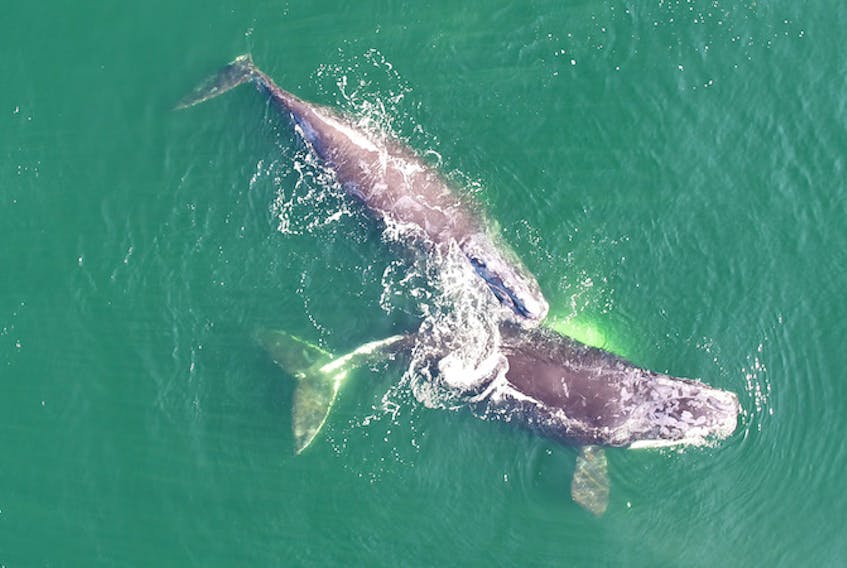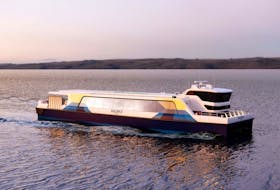The presence of North Atlantic right whales in the Gulf of St. Lawrence comes with a major challenge: understanding where these whales are found, how many there are, and what they do.
Several techniques exist to obtain answers to these questions: observation from vessel and aerial surveys, tagging, and even drones. Another major category of solutions lies in acoustic devices, whether they are underwater gliders, buoys that record in near-real time, or buoys that record the entire season and then are retrieved to download data. Acoustic monitoring is an innovative and interesting tool and a promising solution because whale vocalizations are generally detectable over long distances, making it possible to inventory large areas with a single buoy. These buoys provide information on the number of vocalizations (calls) in the area within a few hours.
Acoustic buoys are promising but still imperfect tools. For an acoustic buoy to be effective, whales must produce calls and even then, it is impossible to understand how many whales are detected, or what they are doing. One can only conclude that they are present, somewhere. Also, since the acoustic environment is highly variable, we speak rather of the probability of presence than the exact number. Finally, since right whales can be detected over a great distance, it is impossible to know where a whale detected within a radius of several tens of kilometers around the acoustic buoy is, nor to know in which direction it is heading. The probability of detection, and thus the uncertainty of the method, changes with distance from the buoy.
In visual inventories (aerial or vessel surveys), the probability of detection assumes a random distribution of whales in the study area. When acoustic buoys are used, the random distribution of whales cannot be assumed to be uniform, because the buoys are strategically placed in the areas where the detections are to be made. These locations are often the most productive fishing areas.
In the majority of scientific meetings on passive acoustics, whenever we talk about detection, or precautionary approach, we are mainly concerned about the probability of not detecting a whale that would be present in the area. Obviously, if a whale does not call, the acoustic tools cannot detect it. This is evidently a risk for a whale that we are trying to protect. But there is also another type of probability of detection, that of making erroneous detections, of recording sounds that are not those of a right whale. Even though the rate of false detections is generally much lower, the resulting management measures also have serious consequences.
One of the strengths of acoustics is that it can provide information in near-real time. This advantage could be used to reopen areas, but at the moment acoustics is being used only one way.
Unfortunately, across all methods used, the efforts deployed to close areas is much greater than the effort to reopen them. Instead of trying to protect the whales, it looks like we're trying to close fishing areas. As if eliminating one cause of mortality was solving the problem. I don't think that's the solution. We have important allies among fishermen who have real power to make a difference. We need to work with them, not against them. We also have promising technologies to help us that are not being used to their full potential.
The right whale crisis in the Gulf is evolving, and I still dare to believe that everyone is doing their best. Sometimes in the rush, we forget critical elements, and we value our efforts with popular concepts like "precautionary approach" and "coexistence". These terms are overused and should be given more attention if we really want to pretend we are integrating them into the way we manage the right whale crisis in this country.
First, one cannot speak of a precautionary approach if risk assessment is a one-way process. In 2020, fishing areas have remained closed, in case the detected whale is actually in that area, not outside of it. The risk on affecting the fishery for no real conservation action was not assessed.
Secondly, as long as whales are the only priority of management measures, we cannot talk about real coexistence, however promising and attractive that term may be. Fishermen are aware of the whales and should care about them. They cannot ignore them. To do so, they have been making considerable efforts for three years now to adapt their way of fishing to the presence of these endangered species on a common territory. However, the approaches, research and measures that aim to protect whales are made without sufficiently taking into account the existence of fishermen.
Coexistence is a buzzword. It's a word that looks good on a meeting agenda. It would be a good idea to rethink this now overused term, and make it real, to coexist. The good news is that we know exactly what needs to be done to achieve it, and the most effective way to do it is to avoid alienating part of the solution.
It is not necessarily the job of whale biologists/conversationists to save the fisheries, but the government bodies that make the decisions have jurisdiction over both aspects of coexistence: endangered species and fisheries. All that is needed is for fisheries and conservation teams to talk to each other and act together. Coexistence is possible. It is not a utopia. It must be given a chance, and the promising technologies available to us must be used robustly to make it happen.
Lyne Morissette, Ph.D, marine mammals and ecosystem ecology for M-Expertise in Sainte-Luce, Que.









